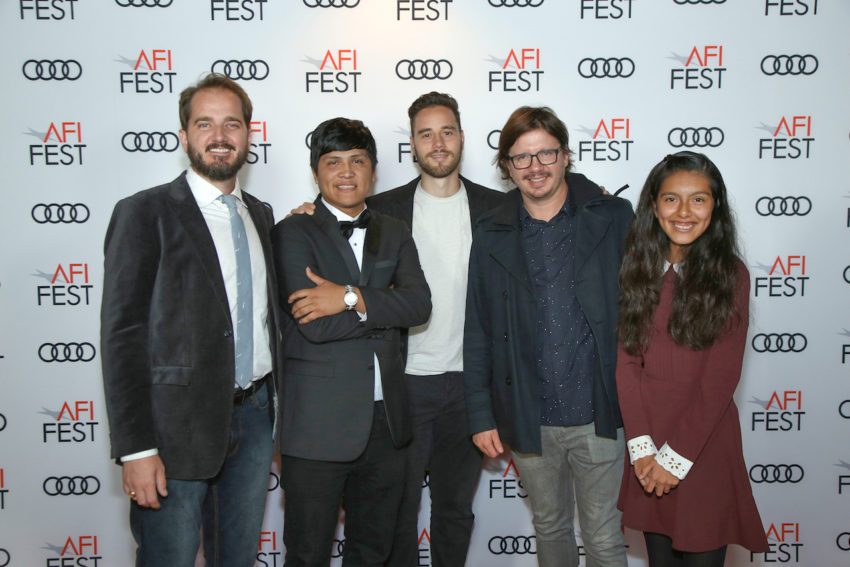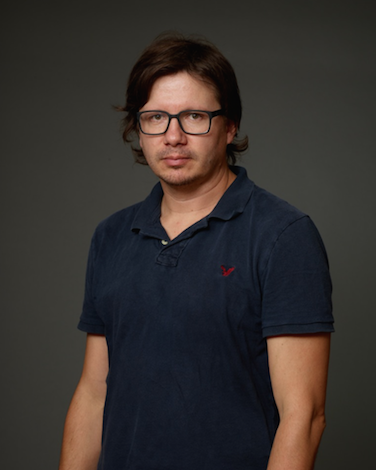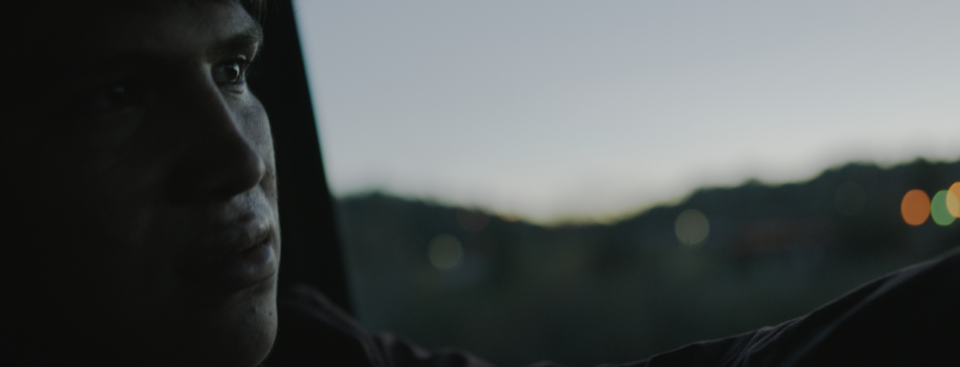
Cast and crew of The Fare at AFI Fest 2017 screening. From L-R Ken Morris,(Producer), Johnny Ortiz, Rasa Partin,(Cinematographer), Santiago Paladines and Noemi Pedraza
HOLLYWOOD, CA (LA ELEMENTS) 11/16/2017 –The Fare, written and directed by Santiago Paladines, recently screened at AFI Fest, the American Film Institute’s annual celebration of movies made here in the US and abroad. Presented as part of the Shorts Program Five showcase on Saturday, November 11 2017 at the TCL Chinese Theater in Hollywood, The Fare is the Master’s thesis project by Paladines for the AFI Conservatory, and is an AFI Fest Grand Jury Prize nominee for Live Action Short Film.
Although the central action of the film revolves around the transport of Cristina, (Noemi Pedrazza) a 13- year old undocumented immigrant from Ecuador, by Javier, (Johnny Ortiz) the emotional heart of this movie deals with the yearning for family – and the desperate lengths that people will go for that connection. Desperation so overwhelming, it drives Cristina to turn to coyotes, or smugglers, to make the dangerous cross-continental journey in search of her mother who lives in Los Angeles. A desperation so powerful that Javier, who is basically a decent person, seeks this sense of belonging from that very same criminal organization. Javier believes that the time he has invested working for them, has forged a powerful bond of camaraderie and acceptance. He discovers later on that not only is this not true, he is actually expendable. Just like Cristina. Also like Cristina, Javier is from the same region of Ecuador. This is problematic as Javier needs to forget the person he once was, in order to do the things needed to move up in rank within the criminal gang he has dedicated his life to.
Cristina and the other migrants she is traveling with are delivered by Javier to a stash house where names and phone numbers of relatives are demanded of them. It becomes clear that although Cristina has already paid to be transported to the US, money for her safe passage will also be extorted from her mother as well. When Cristina doesn’t give out this information, Wellington, (Eduardo Roman) who is the head of this migrant smuggling ring, orders Javier to transport Cristina to Southern California where she will be trafficked. Before taking off on that journey, Wellington demands a final and devastating proof of loyalty and commitment from Javier. One that will change who he is forever.
This is a very dark film and suitably so as it deals with the exploitation of an incredibly vulnerable population, undocumented immigrants. And when one of those immigrants is a 13 year old girl, the tragedy is intensified. As far as the final fate of the two main characters, considering the nightmare world of human trafficking, it’s not giving anything away to say that one will survive this horror, but both will be destroyed.
The Fare is based on true events. Paladines came to the US for his undergraduate studies at Bethany College in West Virginia and would spend his summers in Washington DC where he has family, It was during those college years when he had the chance to meet the people whose experiences on their journey over to the US would convince him that this was a film that needed to be made. We met with Paladines after the first screening of The Fare at AFI Fest to discuss what he hopes people will understand about his film, his plans for the future and much more.

Santiago Paladines
What was the inspiration for you to create this film?
“So, I think it all started many years ago when I did my undergrad here in the US. Things weren’t easy for me and while going through some rough times, I got to know a lot of people who actually had the experience of crossing the border. I would talk to them and because we spent a couple of years together living in the same neighborhood, we became friends. At the time, I didn’t know that I was going to do a film, but I knew that I was interested in touching that human side of this thing that I had heard a lot about before. I didn’t know exactly what was happening to the human being, to the person doing that, who was making decisions that are sometimes wrong, if you can call it that, or decisions that are right. I was interested about that dimension. About the humanity of engaging into this journey and thinking that everything is going to be fine, that you are going to get what you want, the dream you know? And not getting it. Not getting what you expected and stepping into this horrible, horrible chain of circumstances.”
That brings me to my next question. From what you know, when people make this journey, do you think that they’re fully, fully aware of all the dangers of the journey itself? Or is it a case where they’re just thinking of the destination so much that they’re not realizing how horrific the actual “getting there”can be?
“I think they are aware of the dangers. What I have realized that they’re not aware of is the impact, the impact that those events are going to have on them. For example, the young girls who travel alone from Ecuador and other South American and Central American countries, before they start their journey they are given birth control pills by their coyotes, the people who they pay to transport them, because it’s kind of like expected in a way that they are going to be raped. They don’t know how deep that is going to hurt them.”
Would you clarify a few things in the film for me? The image of the Virgin Mary is very specific and in its own way, plays an important part in the movie. Tell me more about this representation.
“So the Virgin Mary, specifically the image that we saw, it’s called La Churona, La Virgen de Cesni del Loja. She is known as the Holy Virgin of the Travelers. She takes care of travelers. It happens that that province in Ecuador, people immigrate from a lot. They are known for being travelers. That’s where most of the children who travel from Ecuador are from. Because Javiar had the pendant with the same image, when Cristina saw that, she knew that he was from the same part of Ecuador that she was from.”

Noemi Pedraza and Johnny Ortiz in a scene from The Fare.
There’s a scene in the movie where Javier is in his truck and he is taking Cristina to a place where people are going to prepare her to be trafficked. At a certain point, he removes the image of the Virgin Mary from the mirror and he does it with anger. What are his feelings at that point? Is the anger coming from knowing that he’s betrayed whatever was inside of him that once made him a good person?
“I think at that moment, he’s struggling with the consequences of what he just did and he also knows that he is someone else inside. So he’s fighting with that decision. He made the decision to be part of this. That’s his sense of success or family. He wants to belong to that. He’s made that decision that he’s going for it and all of a sudden, he meets a girl who reminds him who he was before and he’s conflicted with it and at that moment, I think he’s trying to erase what he just felt. He’s trying to go back to what he has decided. He wants to keep doing what he decided he was going to do. So that moment as she’s looking at the pendant, he takes her away from that. I think there is no way back for him. I think he’s already…something has already touched him. It’s just the last tries. He’s trying to get away from it but it’s got him, you know? For me, I think he’s changed by that time. He’s still fighting it but he can’t go back to who he was before. It’s just a matter of, is he going to do something about it? When is he going to do something about it?”
In the movie, Cristina is subjected to a brutal assault. Not long after that, she is drawing pictures in the condensation of a window pane. This was a scene that I felt had a powerful impact because I felt that it served as a reminder that at the end of the day, these tragic things are happening to a girl who is simply looking for her mother.
“Well that scene, when he comes back to the room taking the clothes for her to change because he’s been asked to take her to this place where girls are taken, you know? That’s kind of like the process. The choice of drawing on the window was hers”.
“We were waiting because the lighting wasn’t ready at the moment and she was already on set and we had like an unexpected break so we said ok, we need like five more minutes. And the camera department, they kept working the light and I stepped out to check on some things. And when I came back, because we were almost ready to shoot, the first AD told me, ‘Why don’t you come to set because we’re almost ready.’ So I came to set and Noemi didn’t go to her dressing room, she stayed there, and I saw her drawing, she was drawing on the window. And I just looked at her, I didn’t know what she was drawing, but I liked it. It was kind of like you are doing something but you are in your head. So she was drawing but it was so intimate. She was so disconnected from anything else that I thought it was a great way to show that she was in to herself rather than…because you would think that when somebody is completely disconnected, they are going to be like paralyzed and sometimes that’s not the case. Sometimes people do things that are a little bit off to what they are and you might think that that something’s off. I found that interesting so I asked her if she could keep doing it and she liked the idea and we went with it.”
So originally, you didn’t know what she was drawing?
“I didn’t know. Then I realized that she was drawing a house and she was writing the word in Spanish, ‘casa’, and she was doing like a kid’s drawing.”
Yes! It was very childlike, making what just happened to her especially horrible.
“I’m telling you something, you know, Noemi, she’s incredibly talented. The choices that she made as an actress, being the first time in front of the camera were overwhelming. She was proposing to me without knowing. She was so into the character that she knew…I always wanted the character of Christina to …I wanted to see how she grows up in the story. How she goes from being a child to becoming an adult too fast. And I was thinking, ‘how are we going cheat that?’ It’s probably makeup. Probably the lighting. She understood that without me telling her. If you pay attention, that’s one of the things that I like in the film a lot, is I see her `after the event, and I look at her face and she seems older. She doesn’t look like a 13 year old. She’s grown. She’s grown up.”
Her emotions are very subtle on her face and at the same time, her expression conveys the damage that has been done to her.
“She took the position to become an adult and to be able to take the position that she takes is something.”
Your movie has already been winning awards. Sometimes in the student division and sometimes not.
“I am very happy with what the film has done. We won the Hispanic Heritage Award. That was very special to me personally. The Hispanic Heritage Foundation, they honor Latinos in the US and they opened this contest for the first time. This was a year ago. That was the first award that we won and for me, it meant a lot because it was a way for me to validate that what we were doing has impacted the people that we…you know, I’m a Latino and I wanted people from my culture to embrace it. Even though it’s a tough story and sometimes there’s many things that we’ve seen about immigration. And for me that meant that we did something special, I felt good about it.”
What do you want people to take away from your film? A film that has as its theme the plight of the undocumented. What’s the message that you want people to get after watching The Fare?
“I want people to see the human beings behind the theme because this is a huge theme. And when I say theme, it’s a theme that we hear in the news, that we read about, that is politicized and is full of stereotypes and clichés in a way, and we tend to think, to have a stand on the issue but without knowing what’s behind it. So I wanted people to know, in a way to have a feeling of what it could feel like to be one of these characters, to see the human side of them. And probably if someone can see that side, then you can start to understand, and for me that was enough.”
“To understand ‘why’, the motivations for both sides, you know? For the guy who is part of the human trafficking gang and for the girl who decides to travel alone. Why does a person decide to do something like that? There are reasons and sometimes the reasons come from love. It’s a contradiction but it’s like that, so I was interested in that. If you understand that I think we are one step away from inclusion, from being tolerant, and if we are tolerant in society, then I think we will be better as a society, if we include everyone and everything.”
Who are some directors that you admire?
“I always liked Roman Polanski. I’m a fan of suspense and mystery, and I think he’s a master for that. But I admire Inarritu a lot. I think his visual language is very strong and poetic but he still has managed to make it universal enough to make people understand it. And also recently, I came across this director from Chile called Pablo Larrain who did Jackie and Neruda. And I admire him a lot. I think he’s a master filmmaker just because of how unique his voice is and how bold his decisions are.”
This is a very acclaimed short film, justifiably. What is next for you after this?
“Well, we actually have written the feature version of the short. We actually started the feature before the short. I had the outline written and then I decided to write the short. So we have that and we’re trying to take that off the ground and hopefully, we’ll turn it into a feature. Besides that, I have a few projects, but I’m just interested in exploring characters that are from my culture and who move around. I like actors that travel, that move from one place to another. So some stories have to do with Ecuador my country and the United States. People that travel, not necessarily with immigration you know. But I’m interested in exploring that and I have a few feature scripts that I have written and they are like floating around. I don’t know what’s going to happen but I have been lucky enough to have good people reacting to them and hopefully the first one will be the feature version of “The Fare” and I’m not planning to stop for awhile.”
THE FARE TRAILER(60SEC) from Santiago Paladines on Vimeo.
All images courtesy of the American Film Institute
Follow AFI Fest on Twitter @AFIFEST and visit their site.
Follow Santiago Paladines on Twitter @spaladines
Follow LA ELEMENTS on Twitter and Instagram. Like us on Facebook.




No Comments